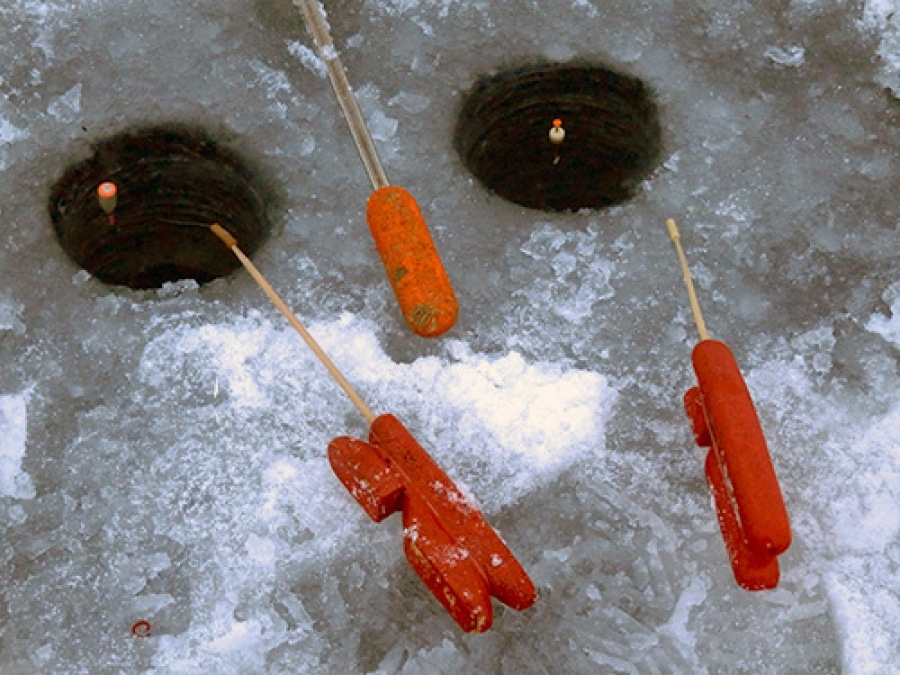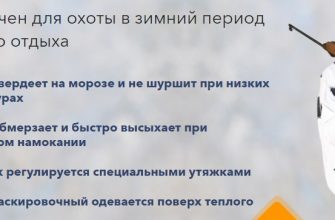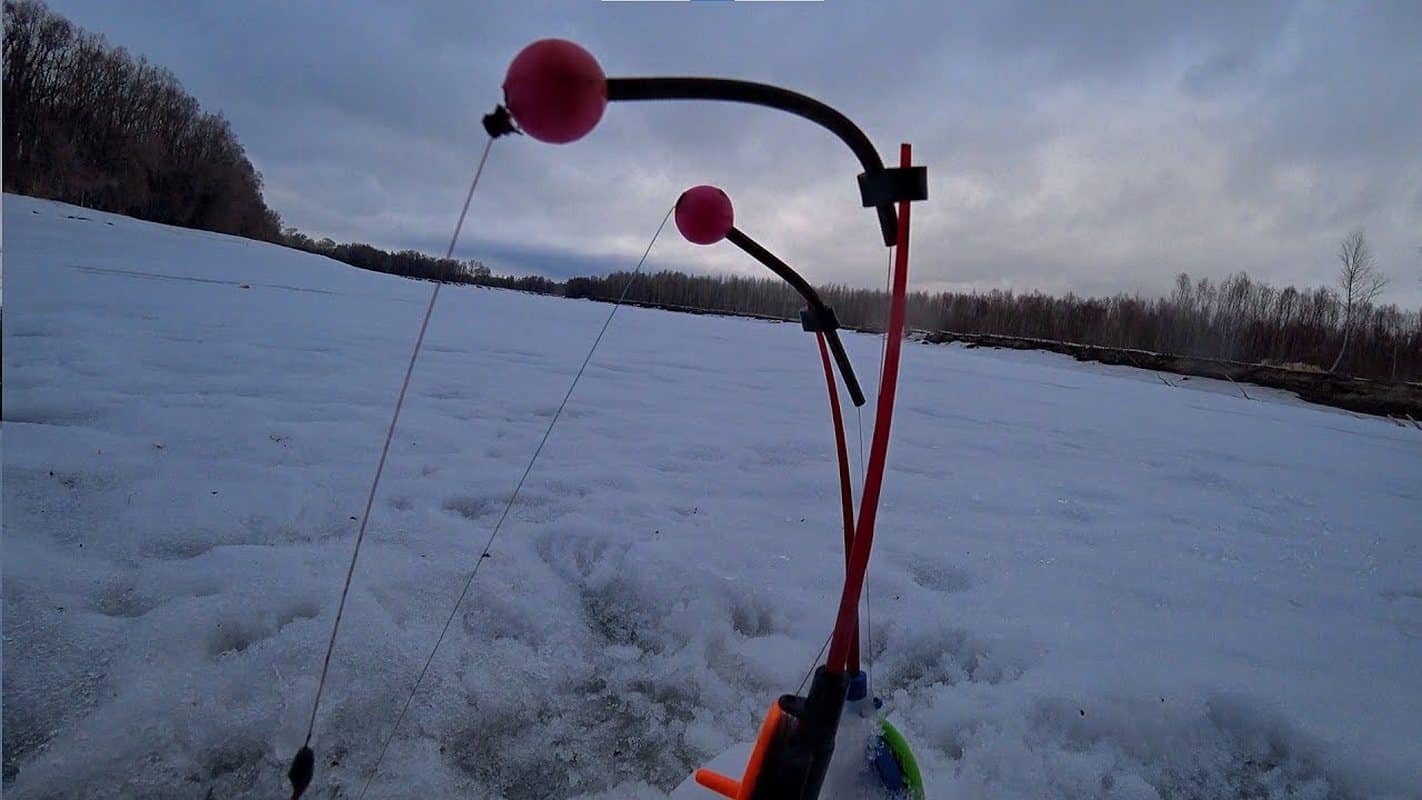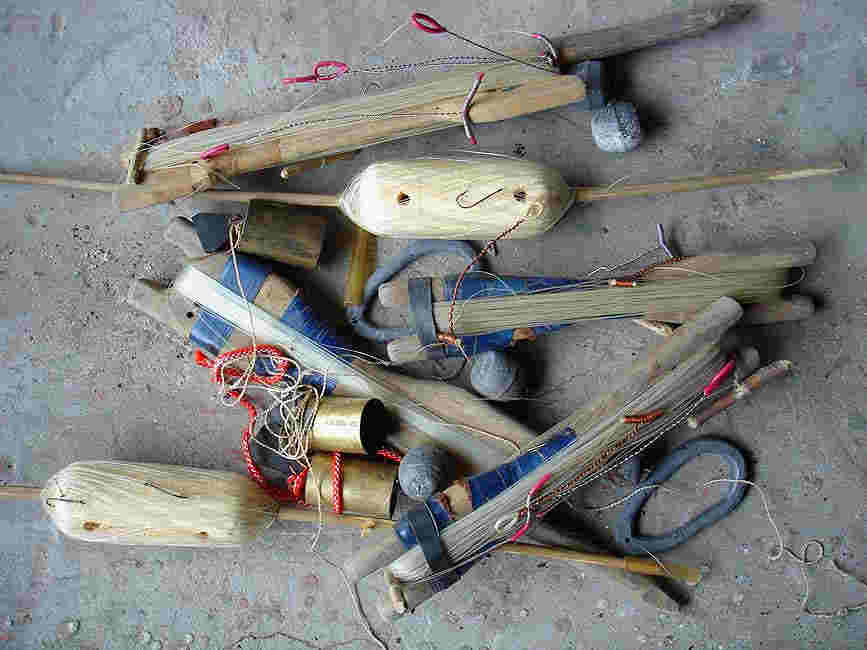Float tackle is one of the tools for winter fishing. It is possible to catch a float in winter with varying degrees of success, and the result depends not only on the willingness to sit over the hole for a while, but also on serious preliminary preparation.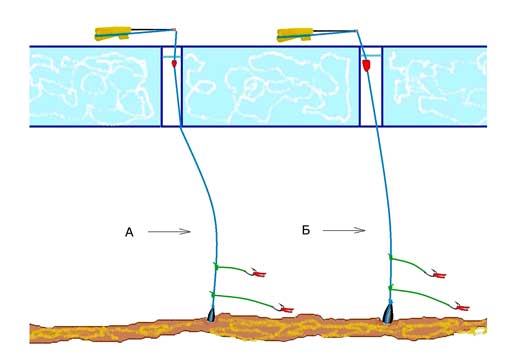
- Winter float tackle – general information for beginners
- How to choose a fishing rod for ice fishing with a float
- Coils
- Line selection – what to look for?
- How to choose a float for winter fishing: photos of popular options
- Float “Flower” – an interesting design for connoisseurs of winter fishing
- Float “Tulip” for winter fishing
- Float “Chamomile”
- Float “Butterfly”
- Separation of floats by parameters
- Float tackle loading
- Hooks
- Other fittings needed
- Installation and assembly of a winter float rod
- Tooling errors
- Setting – different types of loading of a winter float rod
- Float over water
- Float underwater
- Two floats
- Composite floats
- Varieties of equipment
- For fishing at different depths
- For the flow
- For different fish
- Used baits and baits for different fish
- Bait for fishing with float tackle
- Ice fishing tactics
- Поделиться ссылкой:
Winter float tackle – general information for beginners
The differences between winter float tackle and summer tackle lie not only in the size of the rod and the length of the fishing line, but in the shape and weight of the float, in the method of loading, the length and location of the leads and much more. There are also different ways of “working” with a rod, methods of hooking and playing the prey. Here’s how a bobber fishing generally works in winter:
- The bait lures on the hook.
- The equipped line is immersed in the water.
- As soon as the lead touches the bottom, the float is adjusted by movement along the line so that it plunges into the water 1.5-2 cm from the surface.
- As soon as the fisherman notices even a slight movement of the float, he makes a sweep – a sharp, but not strong jerk with the rod.
- Feeling the load on the tackle with his hand, the fisherman begins to slowly pull the line, bringing the caught fish to the hole.
- Trying not to touch the edges of the hole with the fishing line, the fish is pulled out of the water.
The process of fishing can cause certain difficulties, since even a slight touch of a thin line to the edge of the ice can cause it to break and lose prey. The float ice fishing rod includes:
- rod (consists of a whip and a handle);
- coil (possibly);
- stand (possibly);
- fishing line;
- sinker and (or) padding;
- leashes (possibly);
- float;
- baited hook or jig.
The leash is included with the tackle with a caveat, because there are some fishing methods in which the leash is not used.
The device is a winter fishing rod.
How to choose a fishing rod for ice fishing with a float
The main components of any winter tackle rod are a short flexible whip and a tight handle. On the whip, rings can be placed to pass the line and a nod is secured. The handle is made of lightweight, non-sinking material. For factory products, it is light plastic or cork, for homemade rods, it is dense foam or wood. In some regions of Siberia, birch bark boiled in boiling water is used to make the handle. Under the influence of high temperature, the bark folds into a dense roll, from which, after cooling, any object can be cut. It turns out a lightweight and dense handle that prevents the tackle from drowning when it falls into the water. The difference between fishing rods is given by the presence or absence of a line reel.
- A “filly” is a design that has two supports located at the front and rear of the handle from the bottom, which makes the handle look like a sports horse. Supports have a double purpose – directly supports and the place of winding the fishing line during storage. In some views, there is a projection on top, which is also intended for winding the line. Often these rods are made with a removable whip.

- ” Balalaika ” – in this design, the whip is built directly into the reel body, and it also performs two functions – it serves as a handle and a line storage. It can “work” both with jigs ( rewinder and with a nozzle), and with floats. The rod can be supplied with guides.

- Fishing rods with hinged reels . The reels on such fishing rods can be easily removable, and the whips with removable rings. Such solutions allow you to make a collapsible, compact fishing rod.

All of these designs have the ability to attach the nod to the end of the whip, and instead of rings, you can use cambric to pass the line. After choosing a rod, you can proceed with the installation of a winter float rod. To do this, you need to select the necessary equipment for it.
Coils
The equipment of a winter float rod can contain reels of various types for working with fishing line. These can be axial or axial reels for balalaika fishing rods or mounted open inertial or closed spinning reels for other types of winter tackle.
Details on
choosing a reel for winter fishing .
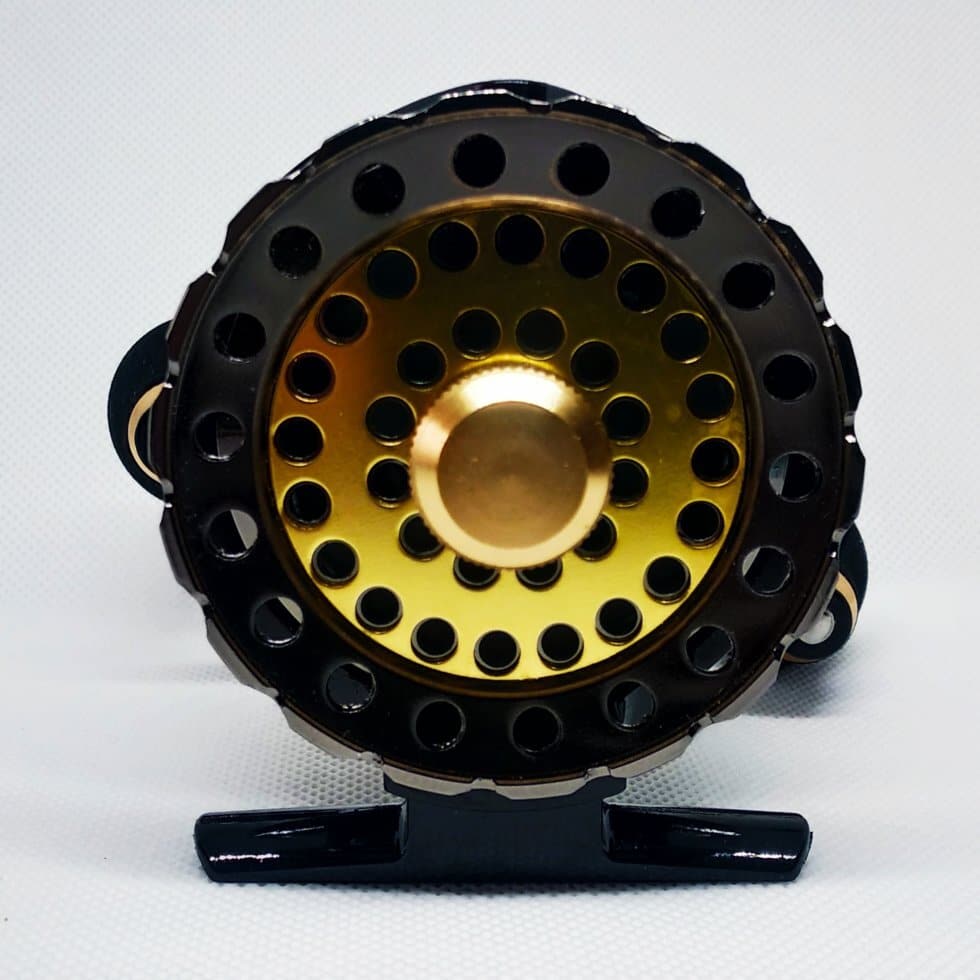
Line selection – what to look for?
Fishing lines for winter fishing differ from summer woods in some respects. So, the equipment of a winter float rod makes serious demands on the fishing line: high strength with a small cross-section; elasticity and, at the same time, acceptable rigidity; lack of “memory”. The main difference between the winter fishing line will be the marking “Winter” applied to its packaging. Lines with these markings are generally thin and can break if mishandled. There are three types of lines used when equipping a winter float rod: monofilament, fluorocarbon and braided.
Monofilament for winter fishing are the most popular, readily available and at the same time have high strength, good elasticity and stiffness. They can be transparent or colored.
Fluorocarbon… The main advantage of this type of fishing line is invisibility in the water – the fish does not see such a line. Fishing lines also have a number of disadvantages:
- high rigidity;
- brittleness at steep bends;
- low strength;
- high price.
Due to the high cost, such lines are used, most often, for the manufacture of leads.
Braided lines . Cords are more durable with a smaller diameter. The low stretch ratio makes the tackle more sensitive than other types of lines. But at the same time, the lack of extensibility can work in the negative, especially when fishing with a short and hard rod. You can break the lip of the fish and break the tackle if you make an unnecessarily sharp movement when hooking. Plus, in the cold, the braids freeze over, in contrast to the monofilament. For this reason, they are either treated with special means, or they prefer monofilament fishing line for winter use. One of the brands of winter line:
How to choose a float for winter fishing: photos of popular options
The ice fishing float is a separate and truly limitless topic. They are produced in a large assortment by the industry, but experienced fishermen almost always make winter floats with their own hands. All winter floats can be divided according to the following parameters.
- Fastening on a line – with a fixed point of fastening, sliding, quickly changing and others.
- Single or compound .
- Float options that change shape when biting .
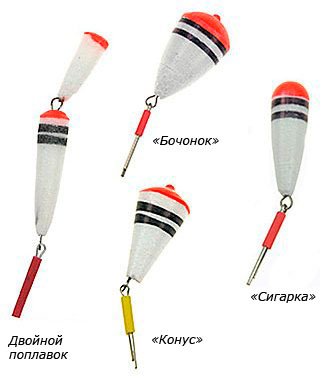
Float “Flower” – an interesting design for connoisseurs of winter fishing
The flower is made of polystyrene with your own hands, this is a float for winter fishing with petals. There can be from 3 to 6. A very sensitive signaling device, it will not miss even the most careful bite. Before the bite it is in a half-folded form, if the bite is “down” – it plunges and folds even more, with a bite “up” – it floats up, dissolving on the surface of the water. On the left – the “bite up” position, on the right – the “no bite” position.
Float “Tulip” for winter fishing
Its design is similar to the “Flower” float, but its petals are bent in the other direction, and it has a tapered main body. The principle of operation is the same as that of “Flower”.
Float “Chamomile”
Float “Chamomile” is the second name of the “Flower” design.
Float “Butterfly”
Float “Butterfly” also refers to the petal, opening when biting, alarms and is used for winter fishing. Unlike other types, it only has 2 petals.
Separation of floats by parameters
In terms of form , the imagination of manufacturers is unlimited here: barrels, cones, cigar-shaped, with and without an antenna. In principle, the shape of the float does not really matter, the main thing is that it is clearly visible in the water and does not miss a bite. For good visibility in the water, it is painted with bright colors, and for a high-quality response to a bite, it must be properly loaded.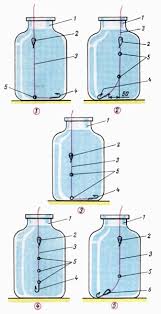
By the method of attachment to the fishing line . Fixed floats – the line is threaded through a through, vertical hole. It is fixed by inserting a small rod into the same hole – the antenna. Fixed float, with a through passage of the line:


Composite… Such alarms can be composed of 2 to 3 parts. Such a design helps to separate the functionality of the float: the lower, large part is responsible for loading, and the upper, smaller part, for the reaction to a bite. The swivel joint allows for more surface area of the sensitive section – a smaller top section requires less effort to move. Therefore, this design has a higher sensitivity than a single float. Composite float, double:
Float tackle loading
Loading is the most important element in setting up a float gear. This process is best done in a warm place, at home or in a winter hut. Loading the tackle consists in the selection of a lead, or lead with a support, so that the finished line with full equipment slowly sinks. In fact, weight is the selection of the weight balance between the carrying capacity of the float and the sinker. The task of the sinker is to deliver the baited hook to the bottom or to the required depth. The float’s job is to inform the fisherman about the bite. A float that is too powerful and a weight that is light will miss the bite. A weak float will sink a heavy sinker so that the fisherman will not see not only the bite, but also the signaling device itself. The process of loading is as follows: the largest load is placed just below the float, then at a distance of 50-70 cm down from it, a pad is attached. It can consist of one or several small-weight pellets,and the last weight should be no closer than 4-5 cm to the hook. Correct loading is such a state of the tackle when it slowly sinks, and the float hangs 1.5-2 cm from the surface of the water.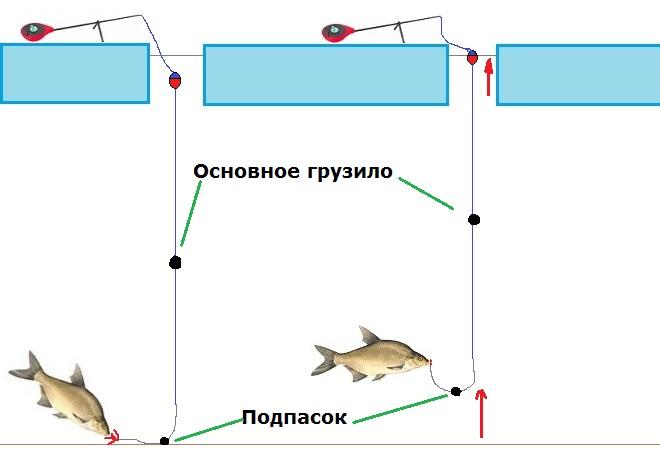
Hooks
In winter fishing, medium-sized hooks are used, because a thick hook does not make sense to knit on a thin line. Hook options for different lures are summarized in the table.
| Type of bait | Hook number |
| Pearl barley, corn, worm | 12, 11 |
| Maggot, caddis flies | 16 – 12 |
| Bloodworm | 24 – 18 thin, dyed in color |
| Dough and other soft baits | 24 – 11 with a spring coil |
Other fittings needed
Even having several options for preloaded tackle in stock, when going on a fishing trip, you need to have in reserve the component parts of the equipment and small pliers for possible repair of tackle. A stock of different types of jigs, swivels, and nods will not interfere with the fisherman.
Installation and assembly of a winter float rod
After preparing all the components of the rig, they proceed to the installation of a winter float rod:
- We prepare the fishing line – its length is equal to the depth of the reservoir, multiplied by 2, and plus 2-3 meters.
- We wind it on a reel.
- We pass it through the rings, put on it a cambric for the float, and another 2-3 cambric, if the whip is without rings.
- We pass it through the float if it is used as a non-removable one.
- We attach a hook or jig.
- We make loading using a set of grains-pellets.
Assembly and installation can be considered complete after 2-3 different rig options have been prepared for the fishing rod. For example, for fishing in still water and for a body of water with a current. The difference in water bodies affects the weight and sensitivity of the tackle. For stagnant water, use a thinner fishing line with a hook or jig at the end. Fishing on the current requires a thicker line and the use of leashes, which means a more powerful float and a heavier load. Installation of a winter float rod – how to assemble the tackle step by step clearly on the video: https://youtu.be/hU2PjNf_rQQ
Tooling errors
No one is immune from mistakes, but the ability to quickly and without loss to cope with them, and distinguishes an experienced fisherman from a beginner. The most common mistake in rigging is the incorrect selection of the “float-sinker” pair. Wrong hook size – trying to “put” a small bait on a large hook. In the case of preparing tackle for fishing on the current, you can make a mistake in the length of the leads and their location on the main line. A real fisherman will never stop because of a mistake, will try, experiment, and in the end will find the necessary equipment.
Setting – different types of loading of a winter float rod
Different setting options apply to different fishing conditions. The flow of water or standing water, the bottom covered with algae or silt, the expected species of fish and many other factors – all this is taken into account when setting up the tackle.
Float over water
An option for setting up a tackle for catching large species of fish in rivers and other bodies of water with the flow of water. When setting up, it is necessary to take into account the weight of the leaders, as well as the pressure of the water on the tackle. The use of a sliding sinker is possible. Large, powerful floats and heavy sinkers are used that can keep the tackle from drift by the current. Strong, thick main line.
Float underwater
Fishing in stagnant or sedentary water. It is submerged not only to exclude the freezing of the float into the ice, the main goal is a high-quality, precise setting of the tackle for catching cautious, inactive species of fish.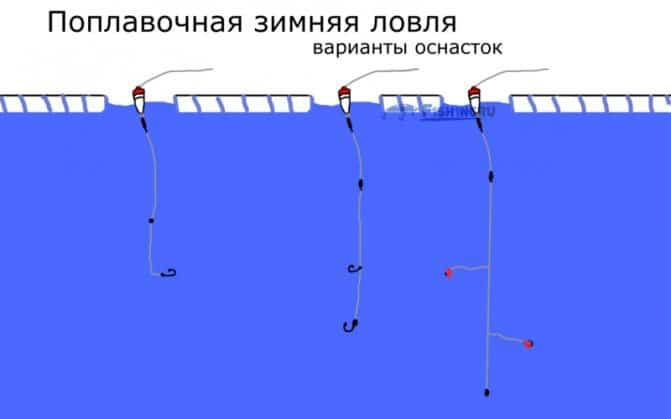
Two floats
Also suitable for fishing in still water. For fine tuning to very light bites. The main float carries the load from the tackle, and the small one is responsible for the bite.
Composite floats
The main task is to catch bottom and bottom fish species. The ability to respond to both raising and lowering the bait, as well as shifting the bait to the side.
Varieties of equipment
The basic rule when equipping a winter fishing rod is the impossibility of creating one, universal tackle for everything. The tackle should be different because it works in different conditions.
For fishing at different depths
The best solution when fishing at unfamiliar depths is to use a sliding lead. In this case, the lead is attached so that it can slide freely along the main line within certain limits. Thus, passing the line through the sinker, adjust the location of the hooks or leashes in depth.
For the flow
The main fishing tool in waters with a weak current is a tackle with a diverter lead. At the end of the main line, in a movable loop-to-loop method, a weight of up to 7 grams is fixed. The leash is tied in the same way – the leash moves freely in the loop. This type of attachment contributes to a change in fishing depth. For strong and medium currents, a “herringbone” is used – 2-3 leashes 15-35 cm long, rigidly attached to the main line. The distance between the fasteners should be 3-5 cm longer than the length of the leashes themselves.
For different fish
The breed of fish intended for fishing is also of great importance. Each breed has its own generic ways of feeding, therefore, the arrangement of gear for catching it is not very similar to others.
The roach is standing at medium depths with varying topography. A tackle with 2 hooks is used – one is bottom, the second is a leash, located above the bottom.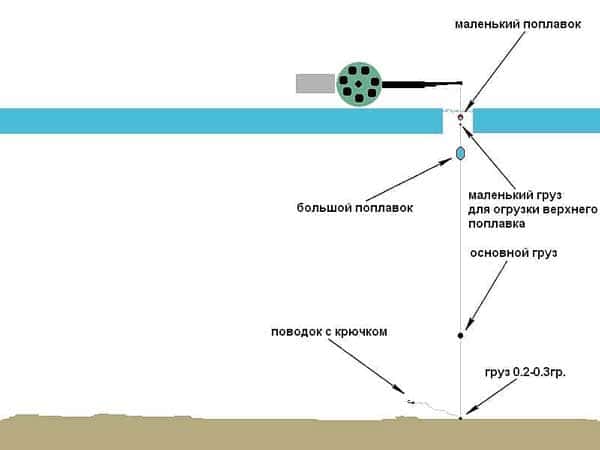
Bream can be active at different depths. First, it “tries” the bait and only then, after a while, it swallows it. Fishing for bream in winter requires a very fine tuning of the tackle, as well as an instant reaction to the slightest movement of the float.
Carp– basically, it takes feed only from the bottom. For him, the most effective is a bottom fishing rod.
Used baits and baits for different fish
Bloodworm is a versatile bait for any fish. But, there are other types of bait:
- maggot;
- worm;
- mormysh;
- semolina talker.
Bait, like the whole process of fishing, is an individual thing. It is almost impossible, especially on an unfamiliar body of water, to guess with the bait. Groundbait is of no less importance for successful fishing.
Bait for fishing with float tackle
Groundbait is almost always needed. However, it is very easy to overdo it on winter fishing, the task is to attract the fish, not feed it. It is necessary to apply complementary foods in advance so that the smell from it spreads through the reservoir. The standard size of complementary foods is the volume equal to the size of the clenched fist of an adult male. The time from the immersion of complementary foods to the start of fishing is 15-20 minutes.
Ice fishing tactics
The basis of winter fishing tactics is constant experimentation and finding those components when the bite is more or less confident: experiments are needed with bait, rigging, and the place of fishing. An important rule is to install as many rods as you can keep track of. The fish does not take to the lured place – try in another place, and then come back. Fish – “comrade” slow, does not like haste. Doesn’t take profit from the bottom – try to pick up the bait, switch to a leash rig. There are many options, you need to constantly try them – a simple sitting over the hole can leave you without a catch. In conclusion, we can say – no, the most practical, article will teach you how to fish better than even one way out on the ice will do it. Communicate with experienced fishermen, follow their habits, think, experiment and luck will be on your side.
